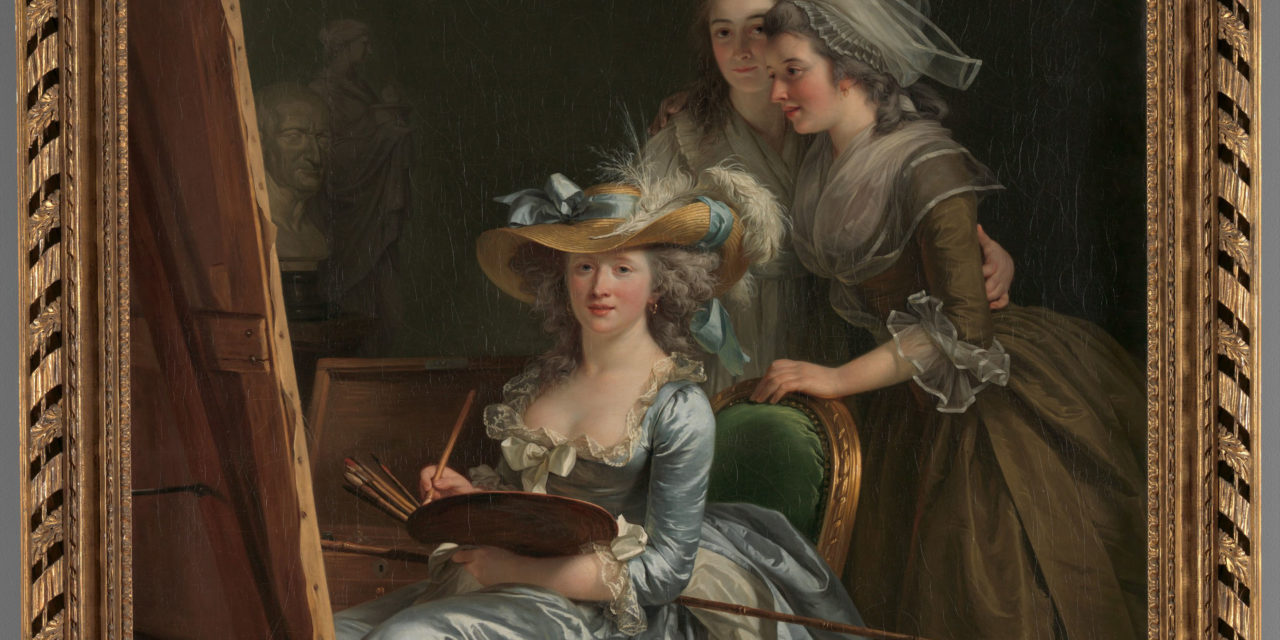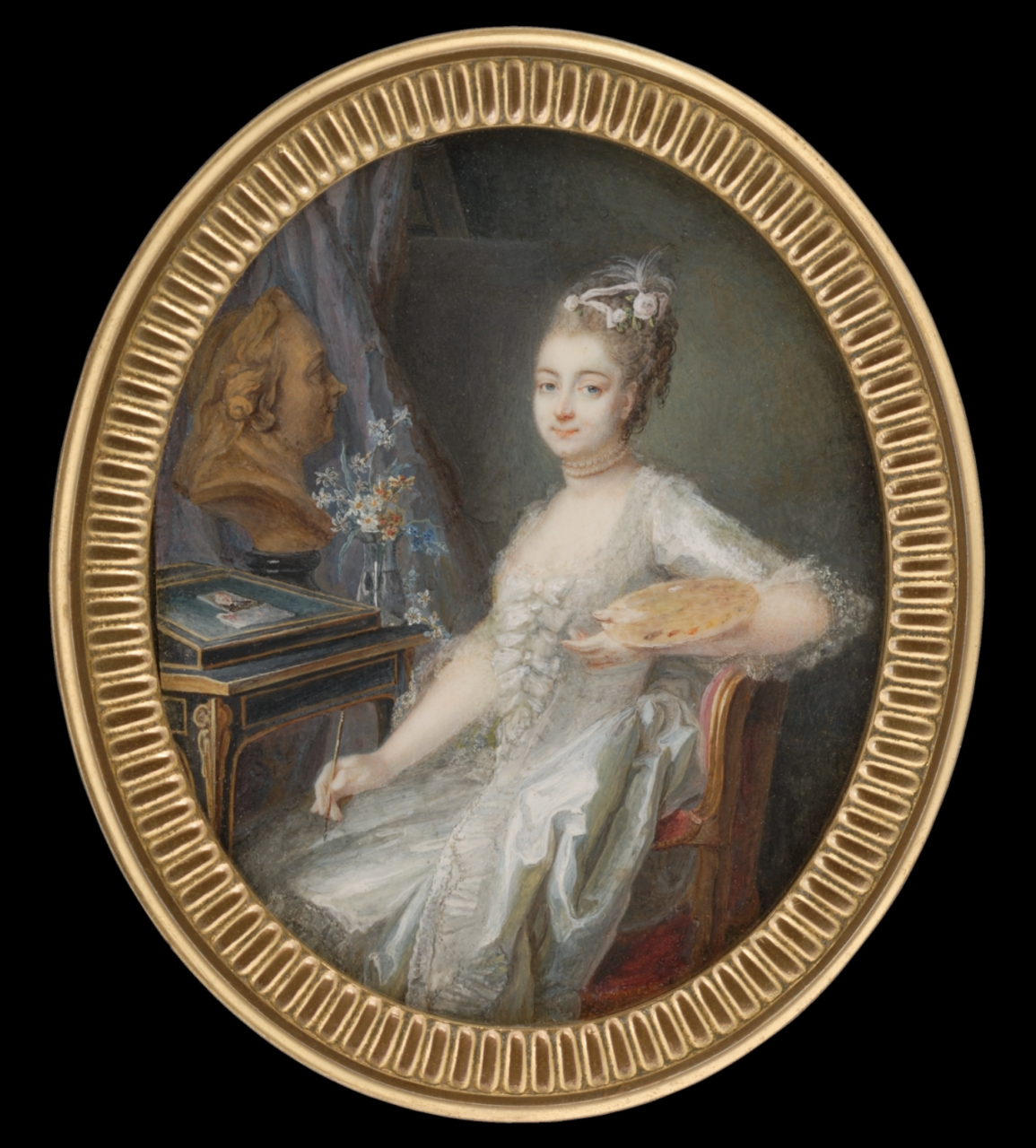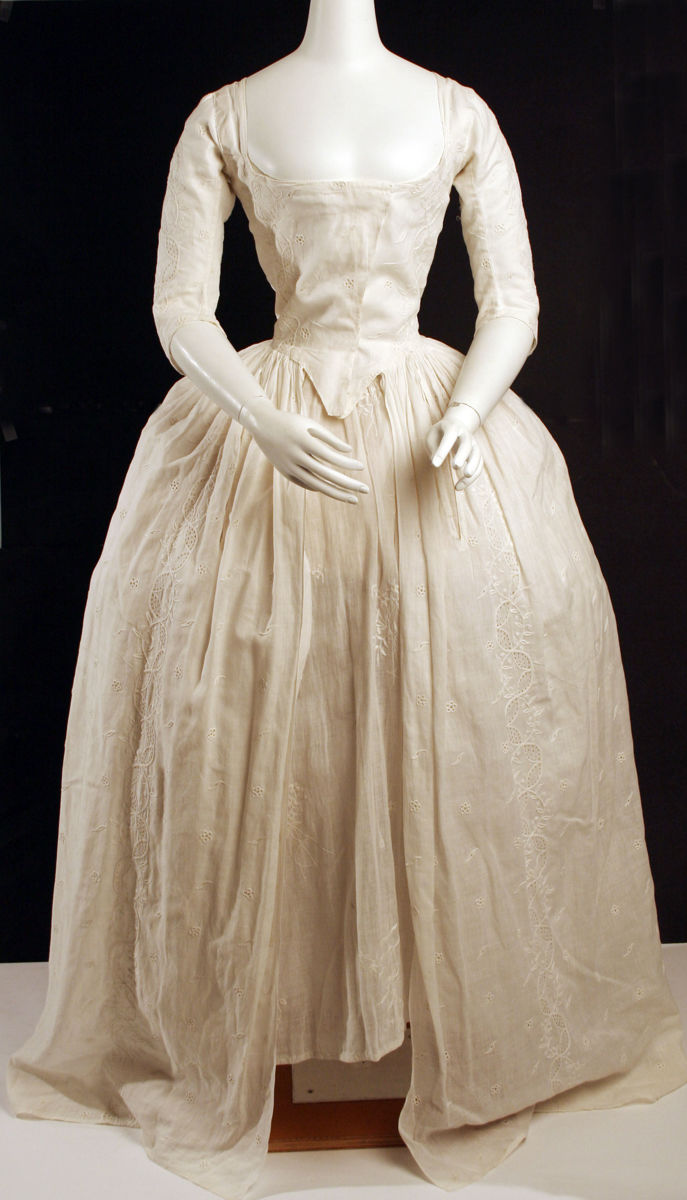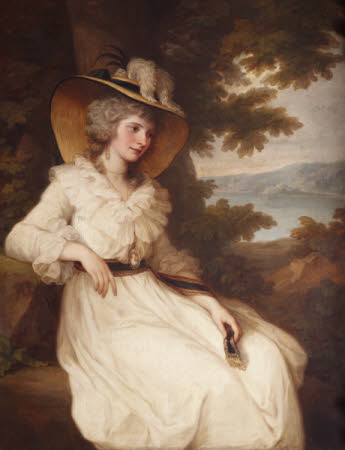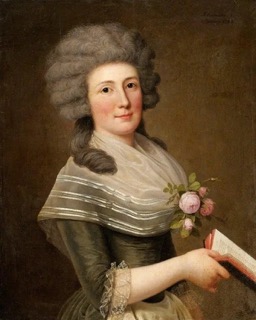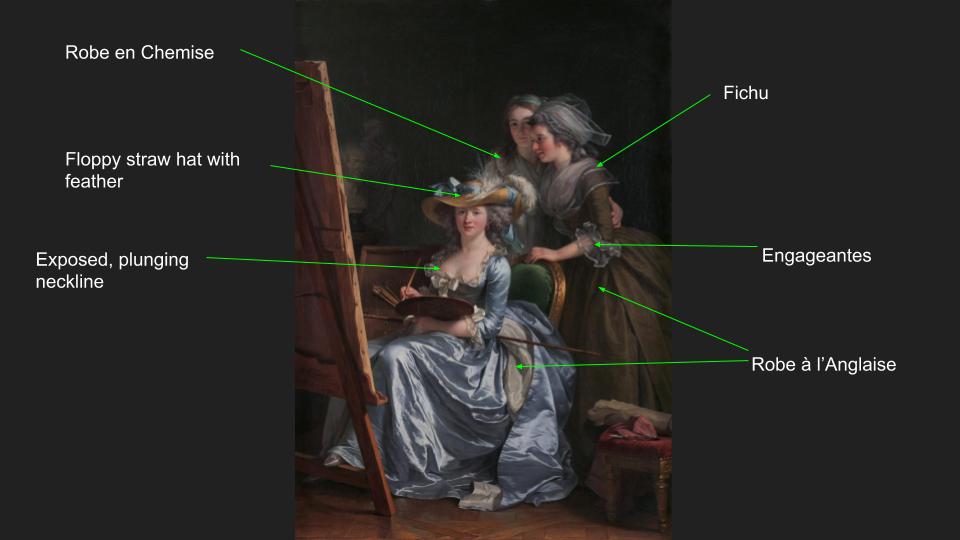The self-portrait of Adélaïde Labille-Guiard alongside two of her students, Marie Gabrielle Capet and Marie Carreaux de Rosemond, shows the influence of the Rococo and Neoclassical styles in the late 18th century.
About the Portrait
The personal history of Adélaïde Labille-Guiard (Fig. 1) and her legacy as a female artist in the late 18th century are explained in her biography by art and fashion historian Kathleen Nicholson. In 1763, Labille-Guiard began her training with the miniature painter, François Elie Vincent. From 1769-1774, Labille-Guiard studied the technique of pastel with Maurice Quentin de la Tour. As an unknown female artist, she had difficulty convincing people to sit for her portraits. Her career took off, however, after she started to show her artworks at the Paris Salon in 1781.
By 1783, she was teaching 9 female students including Marie Gabrielle Capet and Marie Carreaux de Rosemond, who are seen in the self-portrait. Later that year, Labille-Guiard was admitted to full membership in the Académie Royale, alongside Elisabeth-Louise Vigée Le Brun, which was a rare honor for female artists as academy membership for women was limited to four (Nicholson/The Met). A work by Le Brun from 1789 (Fig. 2) shows the similarity of their painting techniques and approaches to female portraiture, which made them quite popular at the time.
Labille-Guiard was a revolutionary woman and artist for her time and unusually independent; she legally obtained a separation from her husband in 1779 (Nicholson). She later took an active role in reforming regulations of the Académie and also advocated for wider admission for female artists.
Fig. 1 - Adélaïde Labille-Guiard (French, 1749-1803). Self-Portrait, ca. 1774. Watercolor and gouache on ivory; 10.3 x 8.4 cm. Celle, Germany: The Tansey Miniatures Foundation, 10418. Source: The Tansey Miniatures Foundation
Fig. 2 - Élisabeth Louise Vigée Le Brun (French, 1755-1842). Comtesse de la Châtre (Marie Charlotte Louise Perrette Aglaé Bontemps, 1762–1848), 1789. Oil on canvas; 114.3 x 87.6 cm (45 x 34 1/2 in). New York: The Metropolitan Musuem of Art, 54.182. Gift of Jessie Woolworth Donahue, 1954. Source: The Metropolitan Musuem of Art
Adélaïde Labille-Guiard (French, 1749-1803). Self-Portrait with Two Pupils, Marie Gabrielle Capet (1761–1818) and Marie Marguerite Carreaux de Rosemond (died 1788), 1785. Oil on canvas; 210.8 x 151.1 cm (83 x 59 1/2 in). New York: The Metropolitan Museum of Art, 53.225.5. Gift of Julia A. Berwind, 1953. Source: The Met
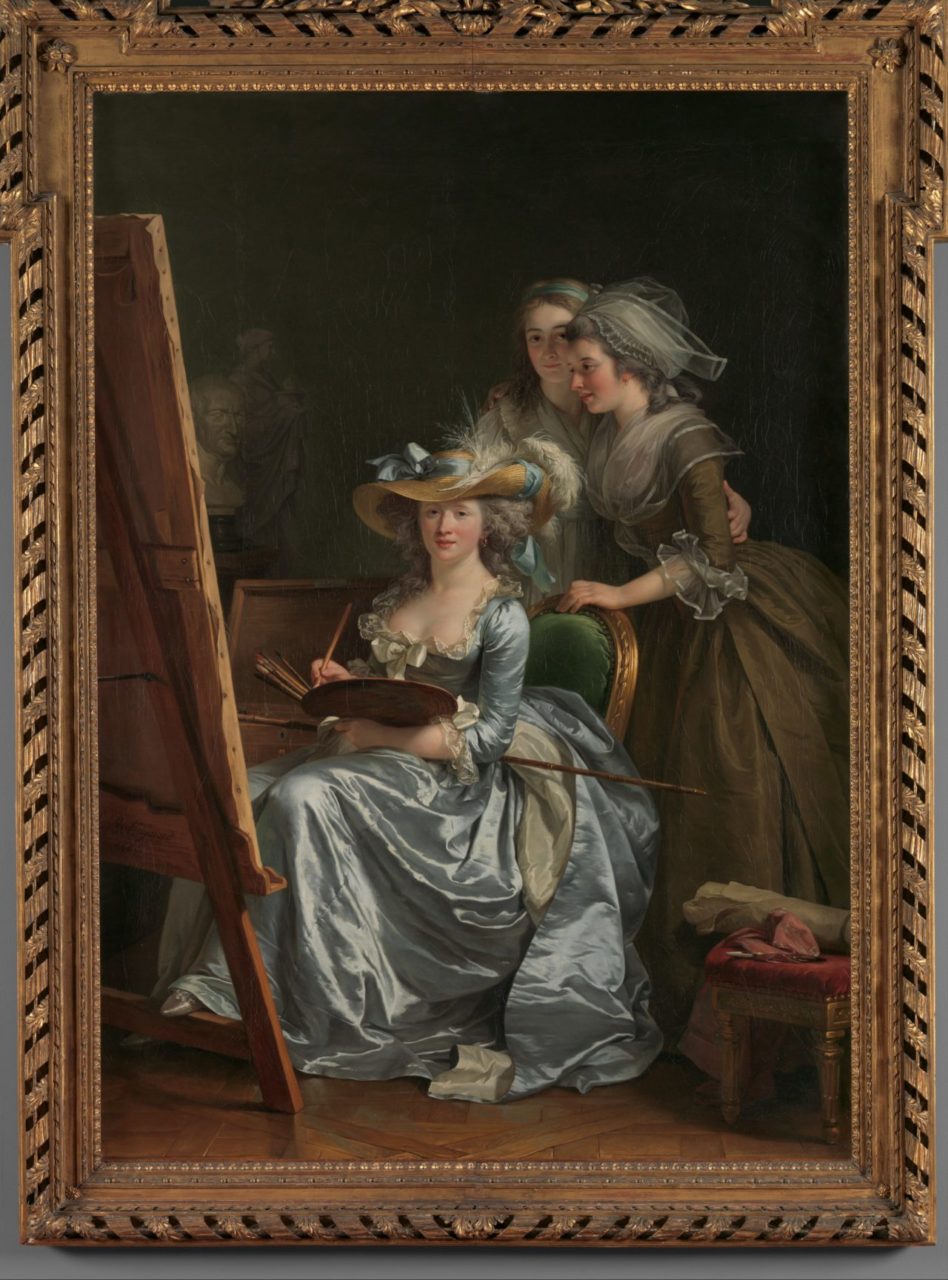
About the Fashion
The self-portrait consists of Labille-Guiard, depicted seated in the blue dress, Marie Gabrielle Capet to the right in the brown dress, and Marie Marguerite Carreaux de Rosemond in the white dress, standing in the background (Auricchio). In A Survey of Historic Costume, Phyllis Tortora and Keith Eubank offer a description of the 18th-century popular styles of dress. These styles included robe à l’anglaise and robe à la française.
“Robe à la française, with a full, pleated cut at the back and fitted front… The robe à la française was more popular in France, robe à l’ anglaise with the English. Although both styles were worn in both countries and America” (193).
Tortora and Eubank also describe the robe à l’anglaise of 1775-1795 as “fitted close to the waist on the front and back” (196). From observation of the open petticoat and gathered or pleated fabric in the back of the dresses, both Labille-Guiard and Capet seem to be wearing robes à l’anglaise. In figures 3a and 3b, the front and back of a robe à l’anglaise are visible, which bear resemblance to the dresses of Labille-Guiard and Capet.
Labille-Guiard paints herself in a style that contains elements of both the Rococo and Neoclassical periods. The dress of the Rococo period was airy, light, sensual and feminine. The colors that filled the period were tints of rose, shell pink, daffodil, soft lilac, and powder blue (Squire 111). The robe à l’anglaise that Labille-Guiard wears is a soft, pastel blue. Labille-Guiard also follows this period’s style with the decoration of elaborate layers of cascading lace at the hem of her sleeves called engageantes (Squire 113). Labille-Guiard is also current to the style with her low plunging neckline and revealing bust line also seen in a similar portrait style of Marie Antoinette by Vigée Lebrun (Fig. 4). Labille-Guiard wears a floppy straw hat more typically styled with a more casual classically-inspired dress known as a chemise dress. Here is an example of Labille-Guiard mixing the two styles of Neoclassical and Rococo. Her silk dress displays the characteristics and lightness of the Rococo style, but she has paired it with a wide-brimmed straw hat, which was typically paired with a cotton chemise dress for a simpler look, as seen on Lady Elizabeth Foster (Fig. 5) painted by Angelica Kauffman.
Fig. 3 - Artist unknown (British). Robe à l' Anglaise, Front, ca. 1780. Cotton, flax. New York: The Metropolitan Musueum of Art, 1982.291a, b. Gifts in memory of Elizabeth Lawrence, 1982. Source: The Metropolitan Museum of Art
Fig. 3 - Artist unknown (British). Robe à l'Anglaise, Back, ca. 1780. Cotton, flax. New York: The Metropolitan Museum of Art, 1982.291a, b. Gifts in memory of Elizabeth Lawrence, 1982. Source: The Metropolitan Museum of Art
Fig. 4 - Elisabeth Vigée Le Brun (French, 1755-1842). Marie Antoinette, Queen of France (1755-1793), 1783. Oil on canvas; 160.5 x 122 x 15 cm. Versailles, France: Château de Versailles, MV 3893. Source: Château de Versailles
Fig. 5 - Angelica Kauffman (1741-1824). Lady Elizabeth Christiana Hervey, Lady Elizabeth Foster, later Duchess of Devonshire (1759-1824), 1786. Oil on canvas; (50 x 40 in). Suffolk, England: Ickworth, Suffolk, NT 851738. Source: UK National Trust Collections
In the background of the portrait, Marie Marguerite Carreaux de Rosemond is dressed in white. It appears that she is wearing a style of dress different from Labille-Guiard and Capet, perhaps a chemise dress (Fig. 5). In the Art of Dress, Jane Ashelford describes this romantic style of dress inspired by Marie Antoinette.
“Marie Antoinette… away from court often wore robes à la creole,.. or ‘chemise dresses’. This dress revolutionary for its simplicity, for in its early form, it was merely a tube of white muslin with a drawstring at the neck and sash at the waist.” (175)
This style, unlike the robe à l’anglaise, is more shape and form revealing. This Neoclassical dress was inspired by the dress of the ancient Greeks, like the chiton.
Marie Gabrielle Capet, to the right of Labille-Guiard, is dressed similarly to the artist in a robe à l’anglaise. As was considered appropriate given her age, Capet is depicted more modestly in comparison to the married Labille-Guiard with a fichu to fill in the neckline. In History of World Costume and Fashion (2011), fashion historian Daniel Delis Hill discusses the fichu and how it was worn for modesty in the 18th century: “a long scarf of linen or lace called a fichu was sometimes secured by a brooch at the décolleté neckline ” (439). The sheer fichu worn by Madame Wittfooth in figure 6 is comparable to the one seen on Capet in the painting. Another example is shown in Figure 7 in a painting done by Labille-Guiard circa 1787; Madame Élizabeth de France is shown wearing her fichu tucked into her bodice.
Fig. 6 - Adolf Ulrik Wertmüller (1751-1811). Portrait of Madame Wittfooth, née Noer, 1789. Moscow: Podstanitsky private collection. Source: ArtHive
Fig. 7 - Adélaïde Labille-Guiard (French, 1749-1803). Madame Élisabeth de France (1764–1794), ca. 1787. Pastel on blue paper, seven sheets joined, laid down on canvas; 78.7 x 65.4 cm (31 x 25 3/4 in). New York: Metropolitan Museum of Art, 2007.441. Gift of Mrs. Frederick M. Stafford, 2007. Source: Metropolitan Museum of Art
This portrait displays the influence of pastels and lightness of the Rococo period and on the other hand, shows styles and characteristics linked to the Neoclassical style, such as the chemise dress. The ladies seem to also be following another trend of Marie Antoinette’s–powdering their hair. Labille-Guiard mixes the two styles in this self-portrait. A key element of the late 18th-century dress that is not exhibited in the portrait is the stomacher. For this statement self-portrait, Labille-Guiard dresses like Marie Antoinette, thus promoting her ability to paint fashionable portaits, while also highlighting her role as a teacher and the important presence of women artists; as the Met notes: “This canvas, shown with great success at the Salon of 1785, has been interpreted as a means of advocating their cause.”
References:
- Ashelford, Jane, and Andreas Einsiedel. The Art of Dress: Clothes and Society, 1500-1914. London: National Trust, 1996. http://www.worldcat.org/oclc/1011807212.
- Auricchio, Laura. “Adélaïde Labille-Guiard.” Harvard Magazine, September 1, 2009. https://harvardmagazine.com/2009/09/adelaide-labille-guiard.
- Hill, Daniel Delis. History of World Costume and Fashion. Upper Saddle River, NJ: Pearson Prentice Hall, 2011. http://www.worldcat.org/oclc/939043732.
- Nicholson, Kathleen. 2003 “Labille-Guiard [née Labille], Adélaïde.” Grove Art Online. 23 Nov. 2018. http://www.oxfordartonline.com/groveart/view/10.1093/gao/9781884446054.001.0001/oao-9781884446054-e-7000048514.
- “Self-Portrait with Two Pupils, Marie Gabrielle Capet (1761–1818) and Marie Marguerite Carreaux de Rosemond (died 1788).” The Metropolitan Museum of Art. Accessed November 26, 2018. https://www.metmuseum.org/art/collection/search/436840.
- Squire, Geoffrey. Dress and Society, 1560-1970. A Studio Book. New York: Viking Press, 1974. http://www.worldcat.org/oclc/990496156.
- Tortora, Phyllis G., and Keith Eubank. A Survey of Historic Costume. New York: Fairchild Publications, 1989. http://www.worldcat.org/oclc/1053943386.

